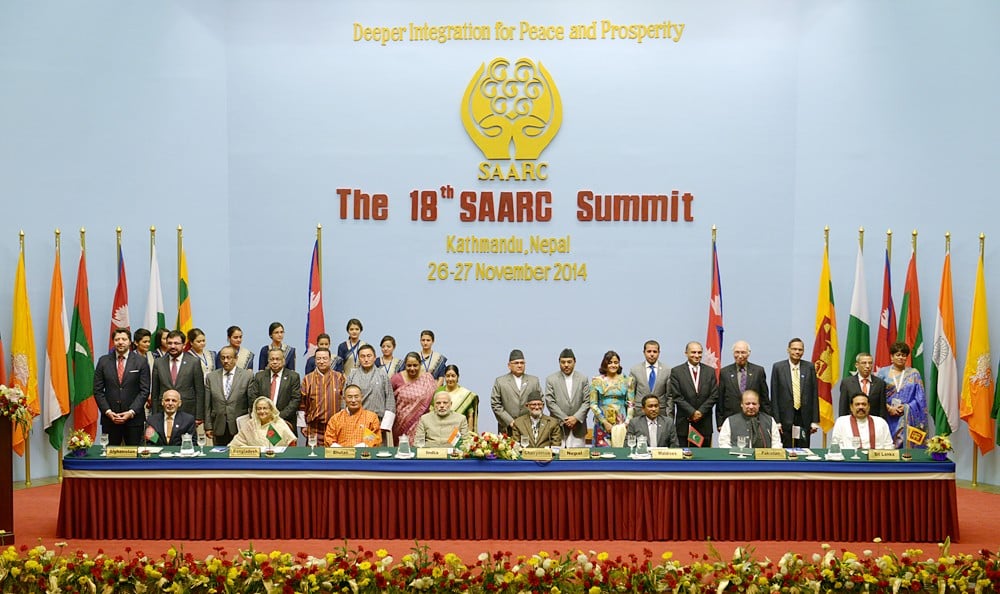
The power system networks of Afghanistan, Bangladesh, Bhutan, India, Nepal and Pakistan could be interconnected to achieve greater efficiency in the overall system

Eighteenth summit’s unanimous agreement, on November 27, to improve cross-border energy trade, if implemented in letter and spirit, could open a new era of cooperation for meeting energy needs of power-starved South Asian states.
Given its potential, the business community and their regional trade body -- SAARC Chamber of Commerce and Industry -- has welcomed the move, terming the agreement "a key to opening a new era of cooperation on energy between the regional countries."
In a statement after the conclusion of the 18th SAARC Summit at Kathmandu, the trade body called for tapping "the enormous energy potential of the region" for the benefit of the people of South Asia. The private sector of the regional countries is willing to play its due role for tapping the energy resources, the statement added.
Fostering of cross-border energy investments and promotion of regional energy trade in order to take full advantage of the energy resources available within the region and its neighbourhood are important elements of the solution to growing energy needs of the South Asian countries. A good example of such cooperation at the global level being that of the South African Power Pool created in 1995, encompassing South Africa, Lesotho, Mozambique, Namibia, Malawi, Zambia and Zimbabwe with a view to provide reliable and economical power supply. This pool works very satisfactorily with immense gain to all participating countries. Likewise, the power system networks of Afghanistan, Bangladesh, Bhutan, India, Nepal and Pakistan could be inter-connected to achieve greater efficiency in the overall system.
At present, South Asia’s cross-border energy trade is limited to Bhutan, India and Nepal at a miniscule scale compared with the need and potential for energy cooperation. However, for some time past, there had been talks for energy trade in the region through Turkmenistan-Afghanistan-Pakistan-India (TAPI), Iran-Pakistan-India (IPI) and Myanmar-Bangladesh-India (MBI) gas pipeline projects.
Revival of trade links between South Asia and Central Asia and the setting-up of regional electricity grids and gas pipelines can tremendously boost economic cooperation between these regions and also meet the growing energy needs of almost 30 per cent of the global population living there.
Likewise, if the traditional and cost effective silk route could be revived it would connect the landlocked Central Asian countries with the world economy, accelerating the process of regional economic, social and political development to the greater benefit of all states in the South Asia and Central Asia regions.
Formally established on December 8, 1985 by Bangladesh, Pakistan, India, Sri Lanka, Nepal, Maldives and Bhutan, SAARC member states, which also includes lateral entrant Afghanistan, have a combined population of about 1.5 billion, which makes it the most populated regional organisation of the world. The grouping was set up to overcome geopolitical hostilities, rivalries, conflicts and to create a culture of friendship, mutual trust, confidence and economic cooperation between the member states. It aimed at promoting the welfare of the people of South Asia and improving their quality of life, accelerating economic growth, social progress and cultural development in the region and providing all individuals the opportunity to live in dignity and to realise their full potentials.
The formation of SAARC aroused hopes and aspirations among the people across the region for a better South Asia through promoting people-to-people linkages, mutual cooperation and free flow across the borders of the region and helping to creating a new era of prosperity. However, contrary to expectations, so far SAARC has failed to fulfil the promised goals of a better South Asia because some member states remained mired in disputes and the biggest state amongst them has not shown the flexibility required of a ‘big brother’ to resolve her disputes with other members of the grouping. As a result, South Asia and its people stand at a very testing and critical crossroads in the history of the region.
Rising energy demand and increasingly insufficient energy supplies are also adversely impacting the economic growth of SAARC states. Unless corrective steps are urgently initiated and implemented, it may be difficult to sustain the achieved and aspired growth rates of SAARC states.
However, it is heartening to note that after struggling for nearly three decades, SAARC now seems to be poised to make some forward movement. But, much would depend on the attitude of its key members -- Pakistan, India and Bangladesh. To transform SAARC from an organisation churning out documents to an effective and vibrant body, in addition to a strong commitment from member states there is a need to set concrete goals and take concrete steps for their timely implementation, otherwise the South Asia region will remain trapped in abject poverty and the people inhabiting it deprived of the fruits of regional trade and economic cooperation.
It goes without saying that economic salvation holds the key to the glory of nations, while mutual bickering, rifts, conflicts and wars not only contribute to belittle their stature in the comity of nations, but also retard their growth and consequently the socio-economic prosperity of their people.
One hopes that the leaders of SAARC states will take a cue from their European counterparts and learn to co-exist after resolving all contentious issues peacefully. But, it is the wise, the bold and the courageous who take historic decisions, the decisions which result in taking the nations out of the morass. However, for want of statesmen -- farsighted and visionary leaders -- the SAARC region has so far remained stuck in the morass created by unresolved issues and the resultant tensions, rifts and wars. Elsewhere, groupings of states, like EU and ASEAN, and the intra-group/region trade and economic cooperation have accelerated the growth of their member states and the socio-economic conditions of their people.
It is high time that SAARC states resolve all contentious issues and start cooperation with each other for economic cooperation and poverty alleviation of their people.